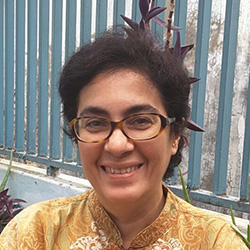Indonesia has been facing challenges with forest fires and haze, particularly during the dry season, leading to environmental, economic, and health concerns. Since 2015, the Indonesian government, under the President’s supervision, has been taking significant steps to prevent and control the forest and land fires.
These steps include the issuance of Presidential Instruction No. 11/2015 that focuses on improving fire control through prevention, extinguishing, restoration, and law enforcement against individuals or entities involved in burning forests and land. The formation of Peatland and Mangrove Restoration Agency (BRGM) followed these efforts.
The Presidential Instruction also increased the role of the communities, in the prevention of land and forest fires and the management of peatlands. Peatland restoration efforts at community level are key to reducing Indonesia’s forest and land fires as well as the country’s carbon emissions, as presented by participants at a recent workshop.
The event on 8 June 2023 in Pekanbaru, Indonesia, brought together various stakeholders to present the results of research based on the participation of fire-affected communities, and to discuss the lessons learned on fire prevention and peat restoration efforts at local level.
The workshop was a collaboration between the Provincial Government of Riau; the Center for International Forestry Research and World Agroforestry (CIFOR-ICRAF); the Center for Peatland and Disaster Studies, University of Riau; and Sedagho Siak, a coalition of local, national and international civil society organisations (CSOs). It was supported by the Temasek Foundation and the Singapore Cooperation Enterprise.
Indonesia’s devastating forest and land fires of 2015, which caused major emissions of carbon dioxide, were primarily caused by slash-and-burn land clearance practices for agricultural commodities, such as palm oil. The widespread blazes became a milestone in the transformation of peat management as well as forest and land fire prevention, prompting a range of initiatives at the district, provincial and national levels.
However, the number of forest and land fires tend to increase a year before key political events, according to Herry Purnomo, deputy country coordinator and a senior scientist at CIFOR-ICRAF. Such events may divert the attention of relevant parties from the threat of forest and land fires, he said.
The intensive efforts of the government, community, CSOs, and all stakeholders in fire prevention will be put to the test with Indonesia’s national elections expected in 2024 and this year’s arrival of the El Niño climate pattern, according to Purnomo.
Warmer and drier weather during El Niño cycles create ideal conditions for forest and land fires.
Since 2021, CIFOR-ICRAF has been engaged in a community-led programme in Siak, Riau Province, which has been at the epicentre of forest and land fires. Purnomo highlighted the programme’s three core points: (i) combining approaches to rewetting peat and business development in line with fire prevention on peatlands, (ii) developing a toolbox, and (iii) facilitating dialogue at the village, sub-district and provincial levels.
Riau is a priority province for the Peatland and Mangrove Restoration Agency (BRGM), which is tasked with restoring about 2 million hectares of degraded peatland and mangrove ecosystems across 13 provinces.
“Most of the efforts made by BRGM involve active community participation, raising awareness about the importance of peatlands, promoting peat-friendly practices, and fostering water sharing,” said BRGM’s Tris Raditian.
Riau Province, located on the eastern coast of the island of Sumatra, is committed to developing a strategic approach in implementing the principles of sustainable development, which is in line with Riau as a Low Carbon Development pilot province, said Febrian Swanda, head of the Watershed, Peatland Restoration and Social Forestry Division of the Riau Environment and Forestry Office.
Some achievements of the ‘Green Riau’ programme include reorienting forest use towards ecosystem restoration and increasing green open spaces; the certification of sustainable forest management in production forest areas; the facilitation of social forestry, including customary forest schemes and forestry partnerships; and the preparation of Regional Action Plans for Sustainable Oil Palm, according to Swanda.
The research took place in Penyengat and Kayu Ara Permai villages in Siak District, where CIFOR-ICRAF facilitated community-led efforts in restoring various types of peatlands, known as ‘Action Arenas’. These areas incorporated diverse business models, such as agroforestry, and emphasized the active participation of women’s groups.
The Community-Based Restoration Monitoring System embraced community participation in tracking the impact of canal-blocking activities, which are essential to the restoration of drained peatland.
As a result of the research, CIFOR-ICRAF developed a comprehensive toolbox, comprising four components: (i) lessons learned from community-based fire prevention and peatland restoration in Phase 1 at Dompas Village, (ii) the augmented Participatory Action Research (PAR) approach based on community input, (iii) a collection of stories and lessons learned about restoration and fire prevention actions in Indonesia and Southeast Asia, and (iv) the Community-Based Restoration Monitoring System.
The ‘Green Riau’ initiative aims to improve forest, peatland, and coastal governance to preserve nature and society. The province’s Peat Ecosystem Protection and Control Plan (RPPEG) focuses on the utilization, control and maintenance of peat ecosystems based on their functions, serving as a planning document and reference for environmental activities at the site level.
Raditian commended the participatory action research (PAR), and its contribution to preventing forest and land fires. PAR focuses on experiential knowledge and action, involving the people who are most affected by the main issue covered in the research.
“We hope that good and concrete results can be disseminated from this research,” he said. “The exposure to today’s experts will be significant in supporting existing efforts.”
We want you to share Forests News content, which is licensed under Creative Commons Attribution-NonCommercial-ShareAlike 4.0 International (CC BY-NC-SA 4.0). This means you are free to redistribute our material for non-commercial purposes. All we ask is that you give Forests News appropriate credit and link to the original Forests News content, indicate if changes were made, and distribute your contributions under the same Creative Commons license. You must notify Forests News if you repost, reprint or reuse our materials by contacting forestsnews@cifor-icraf.org.













